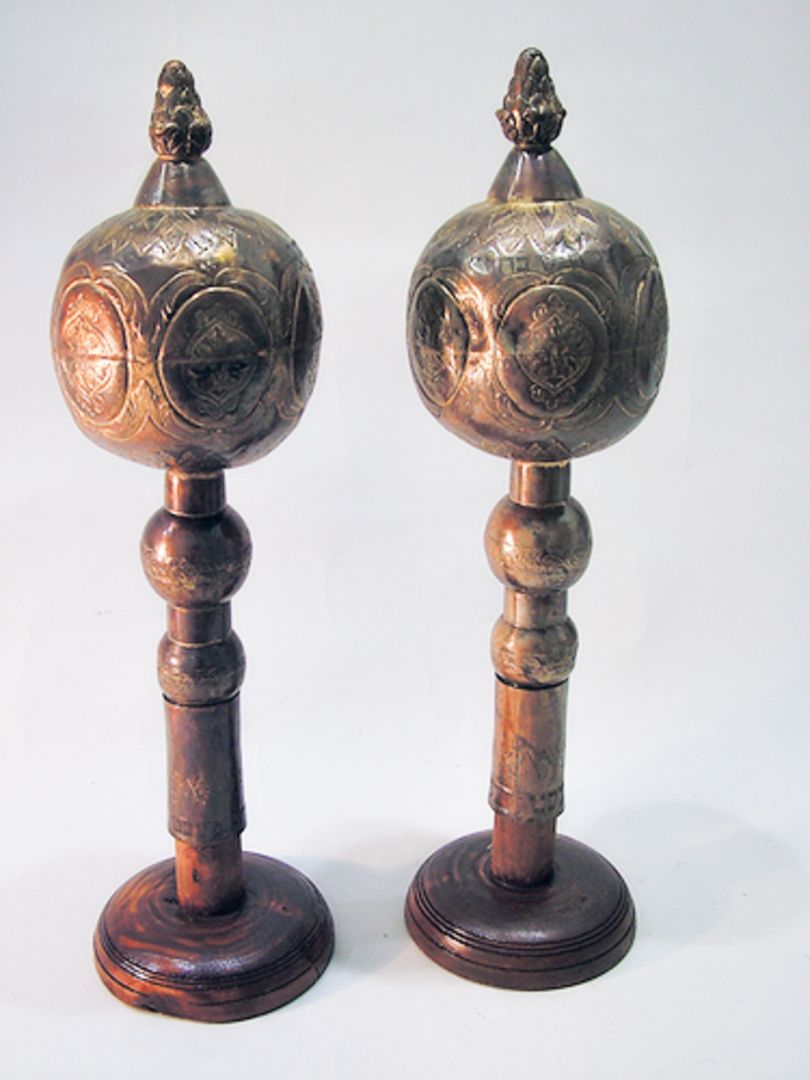2. Hall - 2. view
Torah finials
The oldest ornaments of the Torah scroll are the finials placed on top of the two wooden staves that hold the parchment. In Hebrew they are called rimon, or rimonim in the plural, which means ‘pomegranate’, and which is an ancient symbol of fertility, wealth, and figuratively also of the Torah. There are written sources attesting to the use of rimonim from the eleventh century onwards, but we have relics from only significantly later. The present object, a rimon pair from 1602 with inscriptions, is the second oldest Torah finial known today in the world.
Fitting to the meaning of the original Hebrew name of the object, the top of this copper, embossed and engraved rimon pair has a round form. Its stalk is a roll decorated with two smaller balls with engraved garlands, and its body is decorated with the motive of the pomegranate, with traces of gold-plating. It is a characteristic product of Ottoman-Turkish copper-smiths, and thus probably an artifact of the Sephardi Jewish tradition. On the top of the pomegranate there is an inscription naming the donator: “Tsvi Hirsh, the son of David, 362 according to the short era” (which is equivalent to 1602 CE). ‘Tsvi Hirsh’ is a typical Ashkenazi name, combining the Hebrew ‘Tsvi’ (that is, ‘deer’) with ‘Hirsch’, its German equivalent. The object was thus probably used in a place where the two major Jewish traditions, the Sephardi and Ashkenazi met, or where the local community was in contact with both.
Ashkenaz originally referred to German territories in Rabbinic literature, and later on the term Ashkenazi came to be used for European communities originating from Germany, who initially spoke Yiddish. Sepharad, on the other hand, meant the Iberian peninsula in Rabbinic literature, and Jews who settled in Spanish territories came to be called Sephardi Jews. After the expulsion of the Jews from the Iberian peninsula in 1492, their descendants are also called Sephardi.
According to the inscription on the stalk of the rimon, it belonged to the “Sephardi community in Pest”. This inscription can be dated to a significantly later date than the previous one. The spelling of the name of the city Pest changed with time, and based on the spelling of the inscription, it could not have been engraved on the item before the end of the eighteenth century. It was then, at the turn of the eighteenth and nineteenth centuries that Sephardi immigrants appeared in the Jewish community of Pest. For a time, they had their own prayer house and followed their own prayer rites. But by the beginning of the twentieth century, the Sephardi community assimilated to the Ashkenazi majority.
This rimon pair was presented to the Jewish Museum by Albert Oser, the leader of the Sephardi community of Pest in 1917.
